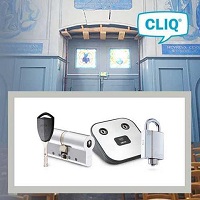
The delicate balance between protecting a precious building and guarding its priceless contents sets a major challenge for access control systems. Invasive installation, showy or inappropriately designed devices and components can’t be considered. This was the situation facing France’s Musée Maurice Denis. The museum is set inside a listed 17th-century monument, so they turned to Cliq access control technology for a solution.
Drawing on extensive experience in the heritage sector, Cliq delivered effective security without disrupting the precious building aesthetic. Installation was easy and wire-free, because programmable Cliq locks are powered by standard batteries inside every key.
Around 70 robust, hard-wearing Cliq cylinders and padlocks now secure doors and windows inside and outside the main museum building; waterproof padlocks also protect boxes housing CCTV cameras on the building’s exterior. All cylinders and padlocks deliver proven resistance against unauthorised intrusion and other threats, thoroughly tested at sensitive real-world locations, including museums, libraries and other public buildings across Europe.
Every employee is granted access to relevant areas via a single Cliq key, which security administrators program with only the appropriate access permissions. Contractors are also admitted via a programmable (and easily re-programmable) Cliq key deposited inside a Traka key-management box protected with a PIN code.
“Cliq enabled us to control access to all our openings, windows and doors, with just a single key,” explains Raphaël Scapecchi, logistics, safety and security officer at Musée Maurice Denis. With Cliq, if a key is lost, its access rights are simply removed — instantly — and it no longer opens any doors. There is no wasting time and money replacing locks or cylinders. The result? Based on three years of successful operation, Cliq is “a huge time and money saver,” says Raphaël Scapecchi











